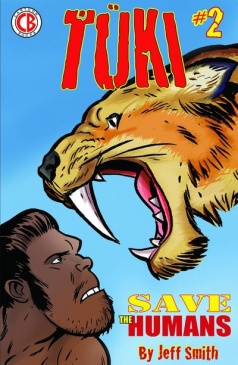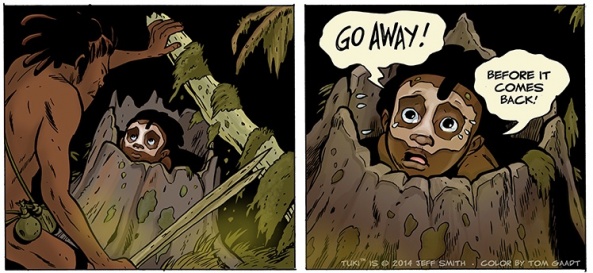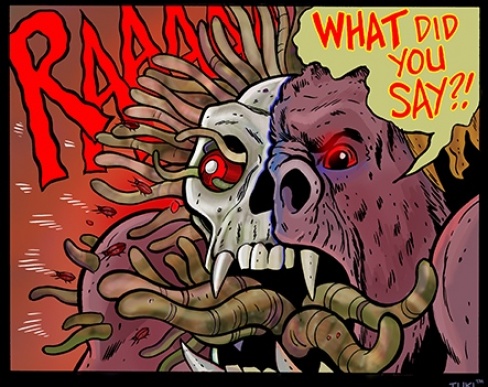Now in print, Jeff Smith’s prehistoric epic continues to unfold as Tuki finds more of his own kind and goes up against ancient gods. At the same time, Smith proves himself further as one of the best cartoonists ever with exceptional linework, expert pacing, and an excellent sense of environment.

Written and Illustrated by Jeff Smith
Tuki the Giant-Killer! Hot on the heels of the award-winning issue #1 (National Cartoonists Society Reuben Award for Best Long Form Comic Online) comes the next chapter in the story of the first human to leave Africa. After meeting and saving a shaman homo habilis, Tuki comes face to face with a sabretooth tiger! And that’s just the beginning! Tuki ignores the shaman’s warning and soon finds himself in the path of an angry giant! Don’t miss an issue of the newest ongoing series from the creator of Bone and RASL!
“Tuki” deals with the first humans to leave Africa and start exploring and expanding to other parts of the world. Essentially, because Tuki took a chance and booked it out of there, he made it so the human race could continue on.
“Tuki” #2 was originally published as a webcomic at boneville.com, but I think there’s a substantial difference in the experience between reading on the screen and reading the comic book itself. When you’re reading it online, you’re only getting one page a couple times a week, so you end up staring at the artwork longer, which allows you to marvel more at the designs and intricacies. For the print version, because of the horizontal format, though you might breeze past the images quicker you get this Sunday comics-like foldout across the full page spread, which helps make the book feel more epic and expansive.
For this second issue (or the “second season” as he calls them for the web version) Smith opens up more of the wider world around Tuki. The old gods have started to make an appearance and they are frustrated and angry about Tuki’s existence. We saw some of that in the last issue with the wizened sage, and now in this one with the ape god, who has some far more personal reasons to be upset with Tuki. (Smith takes some leeway here with an interpretation of Gigantopitheus, this ginormous ancient ape who wandered around the area that’s now China and Vietnam and Nepal.) They pop up seemingly every time Tuki turns a corner, always along with a warning of his impending doom.
Meanwhile, Smith also gives Tuki a companion — this little kid he saves from a sabretooth tiger during the opening. I think this helps lend the story some more urgency, gives us a little more to connect to, and gives Tuki someone else to talk about as he wanders around this dying prehistoric Africa.

Tuki is a cool and methodical character. For the most part, his quest only involves the search for food, but the world he lives in is so barren and desolate he ends up wandering into all these fantastic situations. He’s a survivalist, obviously, so when he meets a monster — whether it’s the ape god or the sabretooth tiger — he has maybe a beat of panic before figuring out how to use his surroundings to his advantage. Smith makes it evident that the chances for humans to survive and thrive in this harsh landscape were astronomical, that it’s a friggin’ miracle homo sapiens made it out of this era at all. Tuki’s naked with only a conveniently placed pouch to carry his tools; he’s armed with dual sharpened sticks and he has little strength of his own, but at the same time, he’s dwarfed by the other animals around him. He’s quick-witted and sharp, and his ability to use his surroundings for his benefit basically gives him his only advantage.
Jeff Smith is a master of pacing and narrative timing. The story, the jokes, the action — you open the page and immediately feel like you’re working with someone in total control of presentation. There’s variety toward the set pieces as well: the sabretooth tiger fight feels far different than the battle with the ape god, while neither of them lose any sense of urgency or danger. I almost find it difficult to measure how much stronger Smith has gotten at this. As far back as “Bone,” Smith’s been able to draw you into his worlds, immerse you in the story. If anything, he’s become even better at bringing you in. He keeps the story moving briskly, but it never feels rushed. His carefully stacked panels with slight movements between figures help give the book a sense of movement, of life and, I don’t know, wonder or something.
Continued belowOne of Smith’s other greatest accomplishments has always been his sets, these environments. The forests and jungles that appear throughout “Tuki” feel far more dangerous, new, and odd than the ones that showed up in “Bone”. The vast desert landscapes have this suffocating and dreary sense that doesn’t feel at all like the mystical and redemptive Arizona from “RASL”. For his previous series, Smith famously visited local parks, woods, and caves and incorporated his versions of these places into the book. I would assume he’s adapted more places from his travels into this one as well. I think his attention to detail for these sets helps sell the story, helps give them this “lived-in” feeling. It’s easier for us to inhabit the world because these characters are inhabiting a world that feels alive. And the sense that this place exists helps sell the story and the atmosphere.

The world Tuki inhabits has just come out of an Ice Age and almost all the water in the world has been frozen in the polar ice caps. Tom Gaadt, who’s replaced Smith’s usual colorist Steve Hamakar for this book, nails the dry and droughty feeling. The dull yellows to puke green gradients that hang around the sky help give the impression that this prehistoric Africa not only burning hot, but crazy dehydrated as well.
Which works great, because it provides such a strong contrast to the more fantastical scenes, where Gaadt favors the more mythical blues and aquamaries. Gaadt pulls this off subtly, and it didn’t interrupt the flow of the narrative or feel at all. Smith, knowing that this book was going to be colored, pulls back on his thick brushwork a bit. He doesn’t have to rely on tricks to help our eyes separate the background from the foreground, and while I think it gives him a little more freedom to move the characters around the page, I sort of miss the weight of his line.
Because the thing is, there are very few inkers out there who can convey the same weight and passion for a figure or a character or background with just a stroke of the brush. You still see that here, but I don’t think it’s as evident as in his black-and-white books. He can sell a tender moment like when Tuki stumbles upon Pup, the lost child, or a terrifying moment like the ape god’s face exploding in grotesqueness, all with the same brush. Similar to Paul Pope and “Battling Boy”, you get the feeling you’re watching a master over here, and know they’re going to flawlessly and breathtakingly deliver the best story they can possibly imagine.

“Tuki” is still at its start, and I feel like there’s much more introductory work going on than substantial narrative momentum. I don’t think much of it has yet struck a satisfying whole, and there’s loads of questions and interests I’ve stacked up over these pages. This issue is also only 18 pages long, which feels a little light. On a more personal note, this is the first Jeff Smith comic I’ve been reading month-to-month, and oh my God I can understand the anticipation and anxiousness readers had while waiting for “Bone” or “RASL”. But when you’re dealing with someone who has as much control and precision with this comic medium, it’s well worth the patience.
Now to wait until February.
Final Verdict: 9.5 – Intriguing, exciting, and endlessly entertaining, “Tuki” #2 showcases a pro just doing what he does best. The art is fantastic, the story interesting, and the characters empathetic. It’s a strong demonstration of the capabilities of the comics medium — from the mechanics to the narrative to the look of it, and it’s starting to show signs at being another great book from Jeff Smith.



